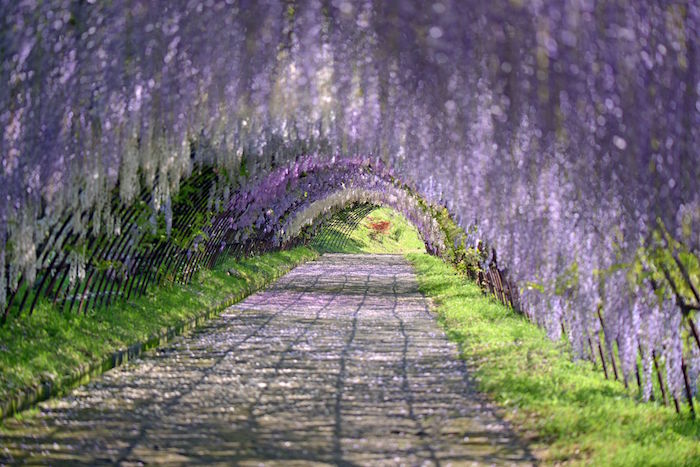View from the Garden: Be Very, Very Wary of Wisteria

The wisteria blooms are glorious and smell wonderful as they sway in the breeze.
It’s so tempting to plant wisteria in my own garden, but I know better. When asked about wisteria, or even when I overhear someone consider buying one, I give my wisteria caution: Know that it wants to, will do everything it can to, and will, if you’re not vigilant, eat your house, your lawn, the pergola, your trees and your neighbors’ property. The lifespan of certain types of wisteria averages 250 years. America’s oldest wisteria vine was planted in 1849 and is more than an acre in size and weighs 350 tons. If you buy one, you will need to find someone who knows how to keep it in bounds. This person will need to visit your house regularly during the season for as long as you have the plant. And when you sell the house, you should pass on this warning to the buyer. Now you have been warned!
One of my clients wanted wisteria on the roof of the guest house. I warned him, but he would not be dissuaded. So I placed a series of brass rods across the roof and, with careful pruning, kept just one branch on each. I returned to the house after not working there for two years. The wisteria hadn’t been cared for during that time and had taken over the roof to the extent that the guest house had become too damp. Needless to say, we removed the wisteria from the roof completely and cut it back to its original size and shape. Now it’s free-standing at the corner of the building and is pruned into a small tree shape.
Another client has one that grows along the porch line of the pool house. When I started the job, the vine had made its way under the shingles and had begun consuming the building. I cut that one back also, and now I keep it at least six inches from the structure.
When I prune an overgrown wisteria plant, I first remove any obviously long tendrils. Then I imagine the resulting shape that I want. Once I have removed enough outside tendrils to see the general shape, I clean out the inside of the plant. The framework of a wisteria’s trunk and branches is very beautiful and I want it to be visible. Next, I sculpt the rest of the plant. Soon after blooming, the plant will aggressively put out new shoots. I remove any that I don’t want and cut the others to five or fewer buds. I do this all summer as those tendrils keep coming. I also remove tendrils from the base of the trunk.
Japanese and Chinese wisterias (those with the long flower clusters) bloom on old wood so they can have a good shaping in winter. American wisteria is a recommended alternative. It makes pinecone shaped flower clusters and grows more slowly, but can reach 30 feet.
Wisteria is a good example of the concept that one should have complete knowledge of the plant one considers buying. Be careful, very careful! But if you are, you can enjoy the beautiful hanging blooms and sweet scent all summer long.
Never. Plant. Bamboo.
Jeanelle Myers is a professional gardener, landscaper and consultant. For gardening discussion you can call her at 631-434-5067. jeanellemyersfinegardening.com



